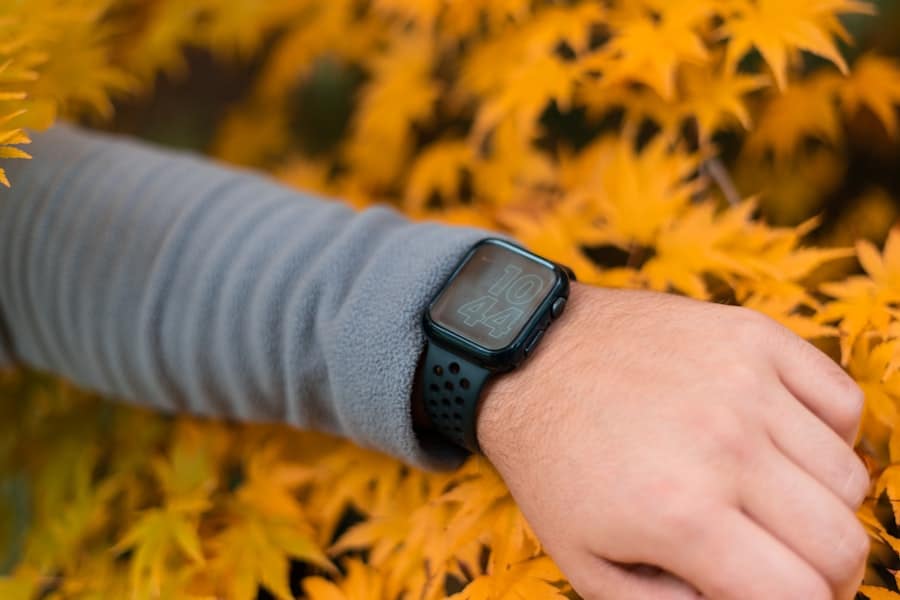The advent of smart wearables has revolutionized the way individuals interact with technology and manage their health. These devices, which include smartwatches, fitness trackers, and health-monitoring gadgets, have become ubiquitous in modern society. They are designed to be worn on the body, seamlessly integrating into daily life while providing users with real-time data about their health and fitness.
The rise of smart wearables can be attributed to advancements in technology, including miniaturization of sensors, improvements in battery life, and the proliferation of mobile applications that enhance user experience. As a result, these devices have transitioned from niche products to mainstream essentials for health-conscious consumers. Smart wearables serve a dual purpose: they not only provide convenience and connectivity but also empower users to take charge of their health.
By offering insights into various health metrics, these devices encourage individuals to make informed decisions about their lifestyle choices. The integration of artificial intelligence and machine learning algorithms further enhances the functionality of smart wearables, allowing for personalized recommendations based on individual data patterns. As the market continues to expand, the potential applications of smart wearables in healthcare are becoming increasingly evident, paving the way for a future where technology plays a central role in personal health management.
Key Takeaways
- Smart wearables are devices that can be worn on the body to track and monitor various health and fitness metrics.
- These devices can monitor and track health data such as heart rate, sleep patterns, and activity levels, providing valuable insights into overall health and well-being.
- Smart wearables can encourage physical activity and exercise by setting goals, providing real-time feedback, and offering motivational prompts.
- They can also promote healthy eating habits by tracking food intake, providing nutritional information, and offering personalized recommendations.
- Smart wearables have the potential to manage chronic conditions, detect health issues early, improve medication adherence, and support mental health and well-being through various features and functionalities.
Monitoring and Tracking Health Data
One of the most significant advantages of smart wearables is their ability to monitor and track a wide array of health data. These devices can measure heart rate, sleep patterns, physical activity levels, and even blood oxygen saturation. For instance, many smartwatches come equipped with optical heart rate sensors that provide continuous heart rate monitoring throughout the day.
This feature allows users to gain insights into their cardiovascular health and adjust their activities accordingly. Additionally, sleep tracking capabilities enable users to understand their sleep quality and duration, which is crucial for overall well-being. The data collected by smart wearables can be invaluable for both users and healthcare professionals.
Users can access detailed reports on their health metrics through companion apps, which often include visualizations and trends over time. This information can help individuals identify patterns in their behavior and make necessary adjustments to improve their health. For healthcare providers, the ability to access patient data remotely can facilitate more informed decision-making and personalized care plans.
For example, a doctor may use data from a patient’s wearable device to assess their response to treatment or to monitor chronic conditions more effectively.
Encouraging Physical Activity and Exercise

Smart wearables play a pivotal role in motivating individuals to engage in physical activity and exercise regularly. Many devices come equipped with features such as step counters, activity reminders, and goal-setting capabilities that encourage users to stay active throughout the day. For instance, a fitness tracker may prompt users to take a certain number of steps each hour or remind them to stand up after prolonged periods of inactivity.
These nudges can be particularly effective in combating sedentary behavior, which has been linked to various health issues. Moreover, smart wearables often include workout tracking features that allow users to log different types of exercises, from running and cycling to yoga and strength training. By providing real-time feedback on performance metrics such as pace, distance, and calories burned, these devices help users optimize their workouts and achieve their fitness goals.
Some advanced models even offer guided workouts or virtual coaching, making it easier for individuals to follow structured exercise programs. The gamification aspect of fitness tracking—where users can earn badges or compete with friends—adds an element of fun and accountability that further encourages regular physical activity.
Promoting Healthy Eating Habits
In addition to tracking physical activity, many smart wearables are now incorporating features that promote healthy eating habits. Some devices allow users to log their food intake by scanning barcodes or manually entering meals into an app. This functionality helps individuals become more aware of their dietary choices and encourages mindful eating practices.
By tracking macronutrients such as carbohydrates, proteins, and fats, users can gain insights into their nutritional intake and make adjustments as needed. Furthermore, certain wearables are equipped with features that analyze eating patterns over time. For example, they may provide feedback on caloric intake relative to energy expenditure or suggest healthier alternatives based on user preferences.
This data-driven approach empowers individuals to make informed dietary decisions that align with their health goals. Additionally, some smart wearables integrate with popular nutrition apps, allowing for a more comprehensive view of one’s overall health by combining exercise data with dietary information.
Managing Chronic Conditions
Smart wearables have emerged as valuable tools for managing chronic conditions such as diabetes, hypertension, and heart disease. For individuals living with diabetes, continuous glucose monitors (CGMs) are a prime example of how wearable technology can enhance disease management. These devices provide real-time glucose readings and trends, allowing users to make timely adjustments to their diet or insulin regimen.
The integration of CGMs with smartphones enables users to track their blood sugar levels over time and share this information with healthcare providers for better management. In addition to diabetes management, smart wearables can assist individuals with hypertension by monitoring blood pressure levels throughout the day. Some devices offer features that alert users when their blood pressure readings exceed normal ranges, prompting them to take action or consult a healthcare professional.
By providing continuous monitoring and feedback, these wearables empower individuals to take control of their health and adhere to treatment plans more effectively.
Early Detection of Health Issues

Detecting Irregularities in Vital Signs
Many smart wearables are equipped with advanced sensors that can detect irregularities in vital signs or physiological parameters, which may indicate underlying health problems. For example, some smartwatches have built-in electrocardiogram (ECG) capabilities that allow users to monitor their heart rhythm for signs of atrial fibrillation (AFib), a condition that can lead to serious complications if left untreated.
Improving Health Outcomes through Early Detection
The ability to detect anomalies early can significantly improve health outcomes by facilitating timely intervention. If a wearable device alerts a user to an irregular heartbeat or elevated heart rate during rest, it may prompt them to seek medical advice sooner rather than later. This proactive approach not only enhances individual health management but also has broader implications for public health.
Broader Implications for Public Health
By detecting health issues early, smart wearables can potentially reduce the burden on healthcare systems through early intervention strategies. This can lead to a significant reduction in healthcare costs and improve overall public health.
Improving Medication Adherence
Medication adherence is a critical component of effective healthcare management, particularly for individuals with chronic conditions who rely on multiple medications. Smart wearables can play a significant role in improving adherence by providing reminders and tracking medication schedules. Some devices are designed to send notifications when it’s time for a user to take their medication or refill prescriptions, helping individuals stay on track with their treatment plans.
Additionally, certain smart wearables can integrate with medication management apps that allow users to log their medication intake and monitor adherence over time. This data can be invaluable for healthcare providers who need to assess whether patients are following prescribed regimens effectively. By identifying patterns of non-adherence, providers can tailor interventions or support strategies that address specific barriers faced by patients.
Supporting Mental Health and Well-being
The impact of smart wearables extends beyond physical health; they also play a crucial role in supporting mental health and well-being. Many devices offer features that promote mindfulness practices such as guided breathing exercises or meditation sessions. These tools can help users manage stress levels and cultivate a sense of calm amidst the demands of daily life.
For instance, some smartwatches include stress monitoring capabilities that assess physiological indicators such as heart rate variability (HRV) to provide insights into an individual’s stress levels. Moreover, the integration of mental health apps with wearable technology allows users to track mood patterns and emotional states over time.
This holistic approach fosters greater self-awareness and encourages proactive steps toward maintaining mental well-being.
As technology continues to evolve, the potential applications of these devices will likely expand further, offering even more opportunities for individuals to take control of their health in an increasingly connected world.
In a recent article on enicomp.com, the importance of smart wearables in preventative medicine was discussed in depth. These devices have the potential to revolutionize healthcare by providing real-time data on a person’s health and allowing for early detection of potential issues. For more information on how technology is shaping the future of healthcare, check out the article on the best shared hosting services in 2023.
FAQs
What are smart wearables?
Smart wearables are electronic devices that can be worn as accessories or embedded into clothing and are equipped with sensors and software that enable them to collect and transmit data about the wearer’s health and fitness.
How do smart wearables support preventative medicine?
Smart wearables support preventative medicine by continuously monitoring the wearer’s health metrics such as heart rate, activity levels, sleep patterns, and more. This data can be used to identify potential health issues early on and encourage the wearer to make healthier lifestyle choices.
What are some examples of smart wearables used in preventative medicine?
Examples of smart wearables used in preventative medicine include fitness trackers, smartwatches, and medical-grade wearables that can monitor specific health conditions such as diabetes or hypertension.
How do smart wearables encourage healthy behavior?
Smart wearables encourage healthy behavior by providing real-time feedback on the wearer’s activity levels, sleep quality, and other health metrics. They can also send reminders to the wearer to stay active, drink water, or take medication.
Are there any privacy concerns associated with smart wearables in preventative medicine?
Privacy concerns related to smart wearables in preventative medicine include the collection and storage of personal health data, as well as the potential for this data to be accessed by unauthorized parties. It is important for users to be aware of the privacy policies of the wearable device and the associated apps.

